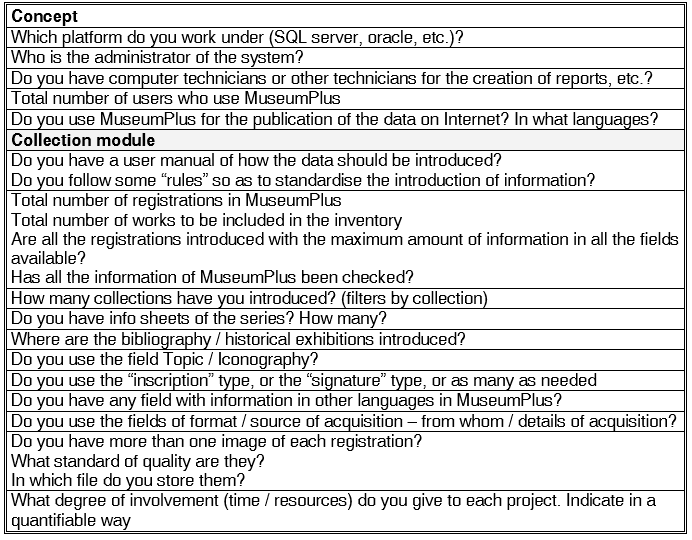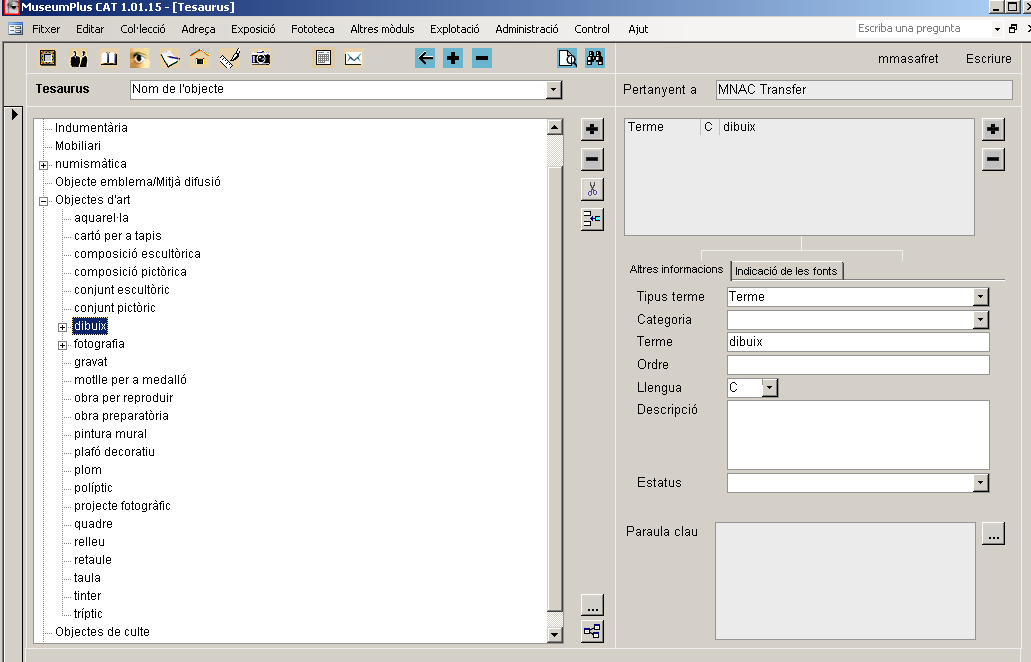Neus Conte/Marta Masafret
In this second article we will explain two of the projects in which we have been collaborating, as parallel and complementary tasks to the daily documentation tasks.
Technical commission for the standardization and development of documentation
The first project is the participation in the Network of art museums of Catalonia and, specifically, in the «Technical commission for the standardization and development of documentation». Our function is to coordinate the tasks of the commission, to achieve one of the goals of the Network, that of «pooling the different artistic collections of the respective museums of the network». We are aware that, to achieve an optimum result, it is necessary to carry out a prior and joint work of:
- Standardisation, systemisation and consolidation of the data
- Creation of a manual of procedures so as to manage to agree common documentation methodologies
With this intention of carrying out good documentation practices, (which, as we already commented in our previous article, were essential), it was clear for the commission that the specific goals should be:
- to achieve unified and qualitatively optimum data to be shared
- to consolidate / share the information in an automated, fast and efficient way
- to improve the training of the users of MuseumPlus (M+)
And we have been working on this since 2014! To date, we now know the current state of the documentation in the member museums of the Network, thanks to some charts that have allowed us to make a comparative study:
During these two years of meetings and of information feedback, we have been able:
-To carry out an exhaustive study of the collections of the museums involved:
- quantify the collections of each museum, if the whole collection is computerised and to what extent (if there are complete files, updated, etc.)
- to know how the works have been formatted, the fields used, etc.
- to know what possible problems we should jointly face
-To carry out a preliminary study of the dictionaries / thesauruses of Museumplus, which will allow us:
- to compare the different descriptors and to unify them → to standardise and systemise the vocabulary to be shared so as to avoid duplicities of authorities, etc.
- to produce a procedures manual of how to create and validate new descriptors → objective: to achieve a good consolidation of data, fast in time and resources
-To get to know the system that we are working on in case there may be some incompatibility in the unification of the data. For example, Oracle, SQL server, etc.
-To choose the languages that will be used and the fields in which the information will be introduced
Our next actions will be:
- to check and standardise the fields to be shared à to standardise the protocols
- to unify terms à use of the thesauruses of the Getty Research Institute (field, name of the object, material) and CANTIC, ULAN, VIAF (author field)
- to create a commission for approval/creation of new terms
- periodically evaluate the project
Change of the thesauruses
The other project refers to our experience as a pilot museum in the change of the current thesauruses of some of the fields of Museumplus (name of the object and material) for the Art & Architecture Thesaurus (AAT) of the Getty Research Institute.
When in April 2015, the Service of Technical and Inventory Support of the Department of Culture of the Generalitat de Catalunya presented its project for the documentation and standardisation of vocabularies to various museums of Catalonia, the Museu Nacional offered itself to be one of the three pilot centres for implementing the Catalan version of the AAT in the field “name of the object”. To do so, this change was carried out with the technological support of an external company, and a working calendar of 10 weeks was established.
Our tasks were:
- mapping of terms: it consisted of looking for each of the terms used in the previous thesaurus and with the corresponding terms in the new thesaurus (AAT). We started out with 413 terms and the final figure at the end of the mapping stage was 446 (378 with correspondence to Getty and 68 without correspondence, for the time being, which we have as our own terms). The final aim of the mapping is not to look for correspondences between “words” but between “concepts”; this means that it’s not enough to know that a term, for example, is “abacus”, but we have to know if the object/s of the museum that we have with the term “abacus” is “abacus: a tool for carrying out mathematical calculations” or that it is “abacus: the upper moulding of a capital”; the same thing happens when you look for the term in the Getty Thesaurus, it’s not enough just to look for the word, you need to look for the concept.
- revision of the structure of the thesaurus (created by the company Nubilum).
- revision of the implementation of the new thesaurus in MuseumPlus (the company Zetcom).
The inconveniences that we have come up against during the process of change of the thesaurus have been diverse:
- The previous situation of the thesaurus was not ideal, due to the inexistence of the maintenance and updating by the institution that created it, something which led, over time, to each museum having to add its own terms as the needs arose. Some thesauruses have become simple lists of words, more or less adequate.
- Another of the difficulties which emerged, was the fact of having to work with the Catalan version of the AAT, which is still a young tool, not developed enough to be considered the main source of reference. Searching for a term in Catalan and finding it or not, is no guarantee that the concept exists or not in the Getty Thesaurus. We are aware that in principle, this is a provisional situation and that as the AAT is used, so the Catalan version will become more established. For the time being, however, this fact has represented an unforeseen inconvenience.

Example of how the name of the object will end up with the AAT implemented (as of now, the test version)
Despite the positive changes that the introduction of a documentation tool such as the AAT represents, it is also necessary to take into account that it is only a tool, and that the success or failure of this tool will be determined by the way we subsequently use it. If we want the new thesaurus to be a really useful instrument, regulations for the indexing and use will have to be established so as to ensure the inter-operability between museums, the Catalan version will have to be maintained and updated, and it will be necessary to determine what should be done with the terms without a correspondence in the Getty Thesaurus. In this sense we think that it will be a key issue to count on the collaboration of the Technical and Inventory Service of the Generalitat, the Termcat and the specialists from the various museums.
We are well aware of the fact that there is still a lot of work ahead of us, but a good inter-disciplinary work, the collaboration between museums and the will to carry out projects that join forces that will help to achieve a better construction of the documentation for the users and to provide visibility of the tools of the documentalists and of the technicians working on these tasks which are so essential for the museums.
So, what do you think, is documentation a grey task?
Recommended link:
Spreading the word: explaining what Museum Documentation is – and why it’s important
This article is the second part of the one already published Documentation in the Museu Nacional: a grey task?
Marta Masafret
&
Documentació de col·leccions










